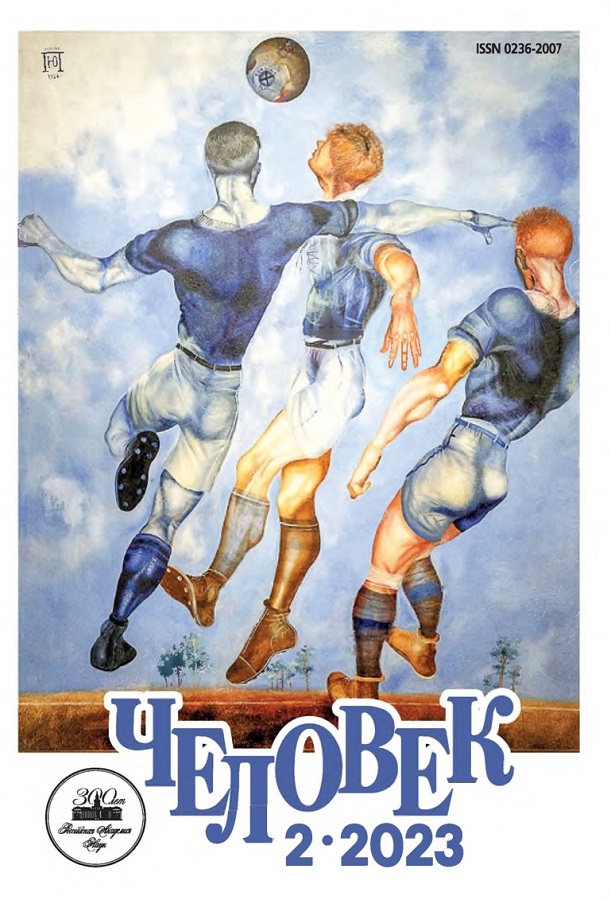Human Being and Recreational Topology in Russian culture of Second Half of the Twentieth Century
- 作者: Politov A.V.1
-
隶属关系:
- Perm National Research Polytechnic University
- 期: 卷 34, 编号 2 (2023)
- 页面: 23-39
- 栏目: Scientific research
- URL: https://archivog.com/0236-2007/article/view/670709
- DOI: https://doi.org/10.31857/S023620070025529-8
- ID: 670709
如何引用文章
详细
The article examines the peculiarities of influence on the formation and development of the spatiotemporal organization of human being of topological structures which are around the individual and external to him and characterizing the concrete historical stage of the development of the Russian culture of the second half of the twentieth century. The methodology and theoretical basis is the chronotopological concept by A.A. Ukhtomsky and M.M. Bakhtin, asserting the immanent interconnectedness of time, space and human, as well as the theory of social chronotope and topological philosophizing. Time and space of human being are understood as a chronotopological structure, which includes a system of topological and related temporal practices, immanent to the individual and developing together with him throughout his life. As a spatial structure that has been formed in culture, recreational topology is studied, which is a closed, well-groomed and isolated from the surrounding space or locus, which is the result of realized human topological practices for the arrangement and care of space or place of residence, work, recreation, scientific research, conservation and demonstration of cultural heritage. Getting into such a closed equipped space, radically different from the surrounding alienated unsettled public space, a person begins to perceive it as a topological standard, consciously or unconsciously transferring and reproducing it in his own individual chronotopology, in the sphere of his personal world and microchronotope of consciousness. If the recreational space is associated with a personally significant event in human life, it acquires the ethical significance for the individual, becomes existentially filled for him, acquires unity with his existence.
关键词
作者简介
Andrei Politov
Perm National Research Polytechnic University29 Komsomolsky prospect, Perm 614990, Russian Federation
参考
- Азаренко С.А. Социально-топологическая методология и топологемы культурного бытия // Музыка в системе культуры: научный вестник Уральской консерватории. 2019. № 16. С. 27–41.
- Амлинский В.И. Московские страницы. М.: Московский рабочий, 1982.
- Амлинский В.И. Оправдан будет каждый час. М.: Московский рабочий, 1986.
- Бахтин М.М. Собрание сочинений. Т. 3. Теория романа (1930–1961 гг.). М.: Языки славянских культур, 2012.
- Бурлина Е.Я., Барабошина Н.В., Иливицкая Л.Г. Выход в город и хронотопия: история, повседневность, будущее // Философские науки. 2019. Т. 62. № 11. С. 27–45.
- Велтистов Е.С. Приключения Электроника. Пермь: Урал-Пресс, 1994.
- Веселов С.А. Мой папа – киллер. М.: Эксмо-Пресс, 1998.
- Гранин Д.А. Ленинградский каталог. Л.: Детская литература, 1986.
- Железняк В.Н. Мышление и воля. Принцип тождества мышления и воли в классическом рационализме и его историческая эволюция. Пермь: ПНИПУ, 2015.
- Кияненко К.В. О феномене, структуре и духе места у К. Норберг-Шульца // Архитектурный вестник. 2008. № 3. С. 98–101.
- Ласкин С.Б. Саня Дырочкин – человек общественный. Л.: Детская литература, 1988.
- Невлютов М.Р. Феноменологические концепции современной теории архитектуры // Architecture and Modern Information Technologies. 2015. № 3 (32). [Электронный ресурс]. URL: https://cyberleninka.ru/article/n/fenomenologicheskie-kontseptsii-sovremennoy-teorii-arhitektury (дата обращения: 25.01.2022).
- Полякова Т.В. Черта с два! // Полякова Т.В. Сестрички не промах. М.: Эксмо-Пресс, 1998.
- Стерледев Р.К. Эзотерический антропокосмизм: философский анализ. Екатеринбург: Изд-во Уральского университета, 2004.
- Ухтомский А.А. Доминанта. СПб.: Питер, 2002.
- Федоров Н.Т. Сказано – сделано. Л.: Детская литература, 1987.
- Черняков А.Г. Онтология времени. Бытие и время в философии Аристотеля, Гуссерля и Хайдеггера. СПб.: Высшая философско-религиозная школа, 2001.
- Ясперс К. Разум и экзистенция. М.: Канон+; РООИ «Реабилитация», 2013.
- Habib F., Sahhaf S. Christian Norberg-Schulz and the Existential Space. International Journal of Architecture and Urban Development. 2012. Vol. 1. N 3. P. 45–50.
- Norberg-Schulz C. The phenomenon of place. Architectural Association Quarterly 8. 1976. N 4. P. 3–10.
- Norberg-Schulz C. Genius Loci. Towards a phenomenology of architecture. New York: Rizzoli, 1980.
补充文件









